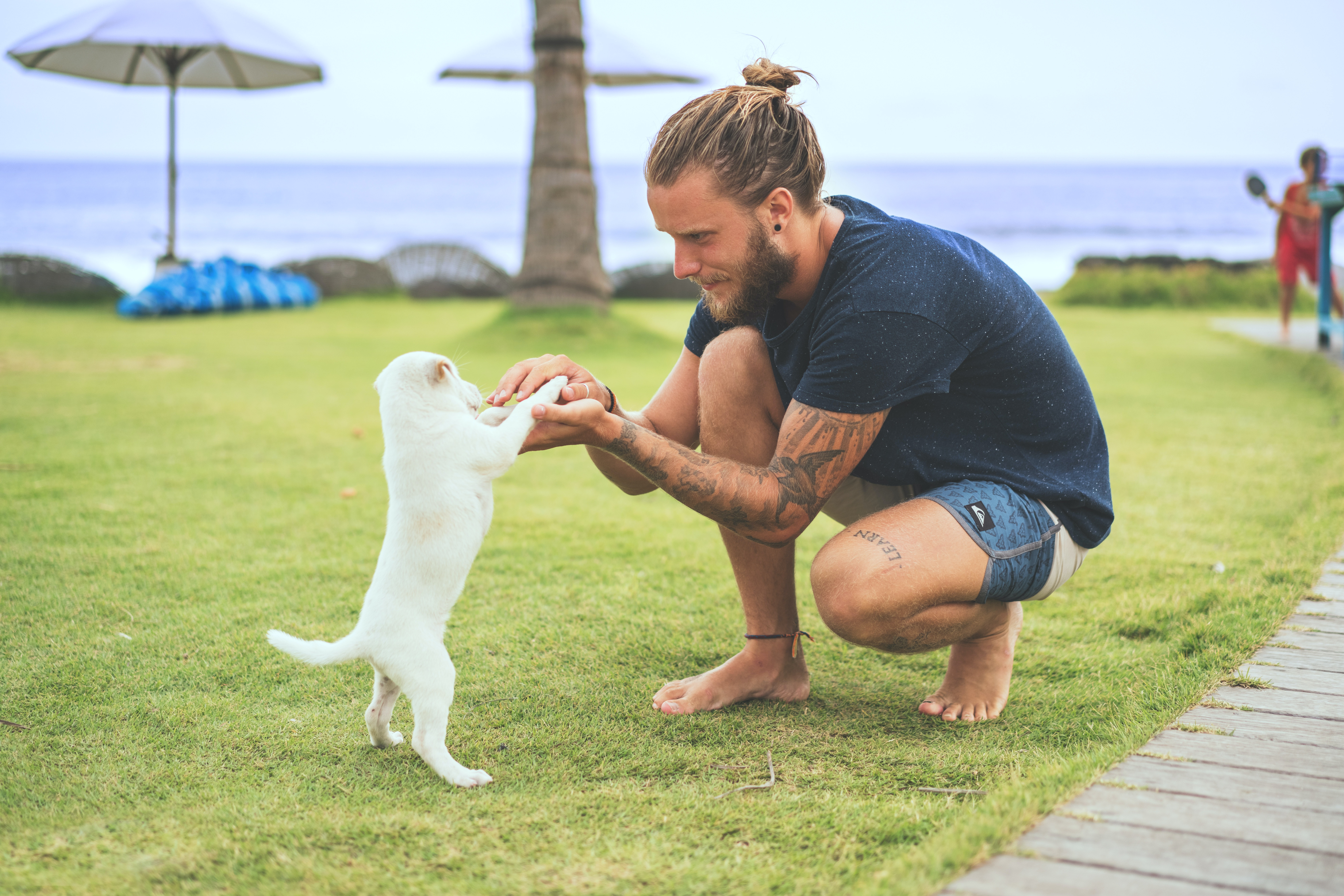
Pets get excitable when someone new visits, and for the most part that’s great! For animals lovers and pets alike, meeting new friends is a great way to build relationships between people and animals. Of course if these people are regular visitors, it’s even better that pets get acquainted with them to avoid any sort of negative interaction when they stop by for a visit.
Not all new people are immediately friends, however. For many pets, it takes a good amount of time to adjust to any sort of new or regular presence in their space. In some more extreme cases, pets may even be aggressive towards unfamiliar people and pets entering their space.
In both instances, it’s important to take the appropriate measures to introduce new people to your pet’s space slowly. Give your pets time to acclimate to a new person, and give new people the heads up they need on how best to approach or handle your pets.
Making New Friends

1. Meet on Neutral Ground
Yes, just like spies exchanging information, neutral territory is ideal for introductions between pets and people. If your friend, significant other, or any other person is going to be a frequent visitor, meeting up at a dog park or some place away from your dog’s home may be ideal. It gives your dog the opportunity to learn a person’s smell and judge their reaction.
If this seems to work over the course of a few meetings, try brief visits and slowly extend the time until your pet seems comfortable with another person’s presence. This will likely vary greatly based on your pets temperament and general experience with people. Even if they cozy up fairly quickly, be sure to keep an eye out for any changes to behavior, just to make sure everyone is getting along without your pet being stressed.
2. Build Positive Association
When a new person enters your home, it can be an unsettling or unexpected experience for your pet. Whether this person is a regular visitor or someone stopping by to deliver something, it’s important to help your pet learn the difference between a positive and negative presence.
The best way to do this is to reward good behavior and maintain a positive environment whenever someone new is around. To reward good behavior, perhaps a treat or affection when a pet is well behaved around guests. In terms of keeping a positive environment, be sure to keep speech and the overall environment of your home neutral or positive until your dog is comfortable with someone new.
Animals, dogs and cats in particular, are very good at picking up on our emotional and verbal cues. Having a negative experience, yelling, or even overly loud and intense positive experiences can alert them and make them uneasy. To avoid this, take extra caution to maintain that peaceful and positive environment around people you want your pets to get along with.
3. Tips for People
No matter how friendly or well behaved an animal is, you should listen to their owner when it comes to handling them or entering their space. Even the most agreeable pet may bite or claw at someone that intrudes on their space unexpectedly. Most pet owners know their pets well enough to warn you how that pet reacts to new people.
Additionally, don’t attempt to force affection or a bond on animals you’ve just met. Watch an animal and ‘listen’ to what it’s telling you based on body language. If a cat or dog comes up to sniff you, wait for it to finish sniffing before you interact. If they show affection, proceed carefully and slowly. Animals are much like people in that they require time to build up trust, particularly if you’re going to be spending a lot of time around them.
Pets can be great companions, but remember that almost all animals have personalities and histories of their own. Just because one dog loves you, it doesn’t guarantee that every dog you meet will feel the same. Some animals have special issues that make them particularly hard to approach, and in all cases, you should be considerate and avoid causing stress for pets whenever possible.
How To Handle More Aggressive or Nervous Pets

1. Follow The Rules Set by Owners
Some pets have unfortunate histories of abuse or neglect that cause a great deal of stress and lasting idiosyncrasies. If someone has adopted one of these animals, or is taking care of them during a rehabilitation period, it’s likely that this person knows what does and doesn’t trigger their pet.
To avoid causing harm to yourself, to the pets, or to anyone else, it’s important that you follow the owner’s instructions carefully. If they say not to stare at a dog, then don’t stare at a dog. If a pet retreats in the home and feels more comfortable away from you, don’t follow it or try to pet it.
Pets that have experienced trauma tend to act very much like people who experience trauma, but they don’t have the words to explain what they’re feeling. We have to rely on our knowledge of their triggers and take care of them as best we can. For new people interacting with pets like these, it’s hard to build any sort of trust without sticking to whatever rules are in place.
Use Equipment When Needed
If you happen to own pets that lean towards aggression and fear around new people, but don’t want to completely isolate yourself from social interaction, you may need to occasionally rely on equipment designed to help curtail a pets outbursts.
Muzzles, weighted vests or vests that warn passers by to avoid contact, and leashes can all be useful in managing your pets around new people. Whether it’s on walks or at home, you may find that for the first couple of introductions, shorter visits with equipment on is a good place to start. Follow that by shorter visits without equipment, and eventually longer visits without equipment.
Even after this point, make sure that visitors are aware of your pet’s needs and experiences to avoid any accidental outbursts or crossed lines between pets and visitors. Taking care of pets that have experienced trauma is wonderful, and it gives people an opportunity to save animals from a shelter and eventually help ease some of that suffering.
At the same time, some pets do well with their owners and not others, and that may not change. So it’s important to be equipped both physically and mentally for the needs and challenges faced by these animals in need.
Respect Boundaries, Care For Pets With an Open Mind
Cats and dogs alike tend to treat their home like a safe space. They get used to their own space, their owners, and any other animals that live there. Whether a pet has experienced trauma or not, this still tends to be the case. When you enter a person’s home, remember that you’re also entering a pet’s home. They may not do well with you approaching them or their things without a good deal of time to develop familiarity with you.
In particular, cats will typically retreat and reappear of their own accord. Don’t go looking for them or move into their safe spaces without good reason, as this disrupts their routine and marks you as a threatening and uncertain presence. Dogs can be similarly affected, or bark and bristle. Remember that these aren’t necessarily aggressive behaviors indicating aggressive pets. These are simply animals that may feel threatened by a new presence in their personal space.
As with all interactions between pets and humans, respect is key. Listen to a pets owner, pay attention to a pet’s body language, and let pets come to you. For owners, be sure to discuss any changes to routine or behavior with your vet after or before introducing new people to your home or pet’s life.
Complete care for pets of every size
At BCP Veterinary Pharmacy, we supply veterinarians and pet owners with the medication to care for all animals, no matter how big or small. Take a look at our products and place your order online.


